31 Jan-11Feb 2014. We are in Puno for Festividad Virgen de la Candelaria. Don is in bed flattened by food poisoning. The first big day of the dance competition begins tomorrow, but I have heard that the people from the villages come into Puno to do their own opening ceremonies today so I set out to see what I can find. Following instructions I head up a narrow cobblestoned street to a kind of square at the top of a hill, past small shops, past many people making their way in the same direction, past a group of tethered horses, and suddenly I am in the middle of a party, a feast, a gathering of hundreds. Many people are dressed in typical Andean dress, many in their special festival dance costumes. Everyone is hanging out eating from big spreads of potatoes, drinking beer, chatting. I can see they are from different villages because of their different costumes, and at the same time the connection between them all is palpable. Once each year all the people from the villages come together for this special festival. And first they have a big gathering and eat and drink together.


In the top photo you can see some branches tied up in serapes. Everyone has bundles of branches, great high mountains of leaves and bushes, and they parade through the streets with them, in their arms and on their backs, and those in the dance groups, dressed in their special outfits, dance through the streets all the way down to the big cathedral, around Plaza des Armas, and then back up to the square in front of the Church of San Juan, the home of the effigy of the Virgin of Candelaria.
And then, to my complete astonishment, in their many separate groups they pile up the branches and leaves and bushes in the street and set fire to them! All around the square each group makes its own special ritual around their fire. A lot of beer drinking is going on. Every drinker from time to time splashes beer onto the ground to honour Pachamama the Earth Mother. Some groups dance around the flames. Some groups have dancers in special costumes. A lot of poking and stoking of fires is going on, and a lot of dancing, and a lot of milling around. And music. Non-stop music of the Andes.
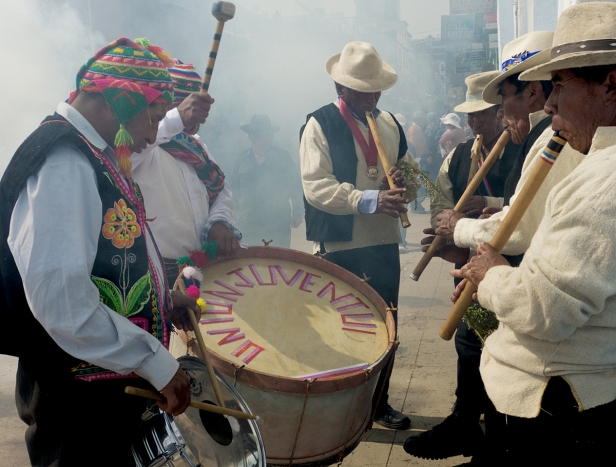
As usual I’m bopping along with the music, and suddenly the man in the orange shirt pulls me in to dance with him.
After a while I move on to another group. This group seems to have the most elaborate ritual of all. I think I hear chanting. A man throws something onto the fire that sends up sparks, and then he drinks some beer and splashes some on the ground for Pachamama. Then a woman, one of the elders of the village, performs the same ritual.
This ritual is followed by traditional dancing.
As usual I have wriggled my way right to the front where I sit on the ground so I don’t block anyone’s view. Next thing I know there are four horses dancing in the circle in front of me. Suddenly it doesn’t feel safe and I try to move back a little, but they are excellent horsemen and I watch it all without being trampled.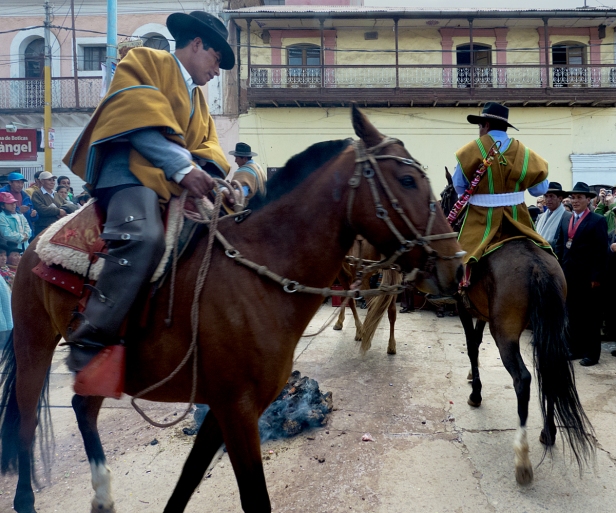
And all this is just the beginning.
Each year, high in the Andes in Puno, Peru, the Festival of the Virgin of Candelaria takes place during the first two weeks of February, and rivals Rio de Janeiro’s Carnival in size, scope and brilliance. The sheer size of Candelaria is staggering: fifty thousand dancers, and fifteen thousand musicians, plus another twenty-five thousand indirectly involved including the many artisans who make the extremely elaborate costumes, hats, shoes, bells and masks. Like all festivals in South America it is a rich mix of the indigenous sacred practices, both Aymara and Quechua, and Catholicism. Throughout the days of Candelaria there are dances and ceremonies dedicated to Pachamama and the other indigenous gods. At the same time there are masses and solemn processions for the Virgin of Candelaria. It all blends together.
On the first Sunday in February a dance competition is held at the stadium. These are the dances of the people from the villages and are called autoctonas. This year there are one hundred different groups with anywhere from one hundred to three or four hundred dancers and musicians in each group. The program said it would start at 7am and finish at 3pm. We arrived around ten and lasted for about five hours, by which time we’d figured out that the 3pm finish was wildly unrealistic. In a stroke of spectacular luck we were able to get in to watch the dances from the press area instead of having to watch from behind the wire fence. I related the story of how that came to pass in this post.
That day I took nearly 1300 photos. Here I offer a selection that I hope conveys something of the extravagant orgy of dancing we witnessed. One after the other the groups paraded onto the field, took their places, and danced their hearts out. As they filed off the next group, waiting on the sidelines, immediately took their place. It seemed with each group the costumes became more and more elaborate and colourful. Some groups had masses of leaves draped around their necks, some had masses of party streamers draping riotously from their hats, and many had great bunches of flowers on their hats. Beading and embroidery and flying skirts and scarves and feathers were everywhere. Almost all groups had dancers in matching costumes, with perhaps one or two or half a dozen special characters in the mix. In one group there was a man dressed in a leather jacket and high boots and a cowboy hat, wielding a pistol and a whip. Another group had a man dressed as a condor. One group had all the dancers spreading a grid pattern of bright yellow petals all over the dance ground before they commenced dancing. All groups had children participating, even toddlers. And in all groups the musicians, with their panpipes and flutes and drums, moved in choreographed patterns on the dance ground along with the dancers. Covering a whole football field, it was a joyous riot of colour, and movement, and flying feet.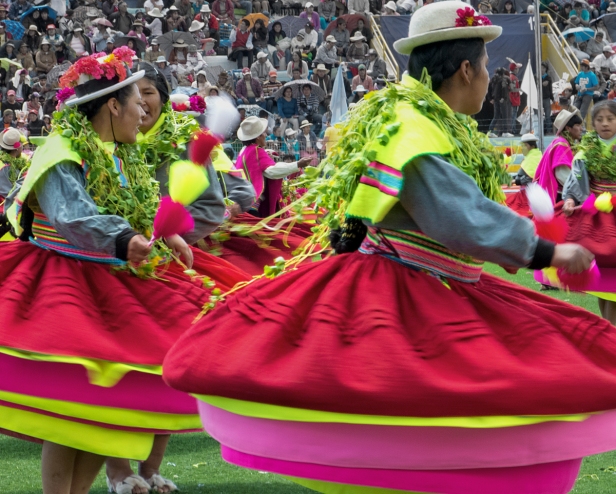
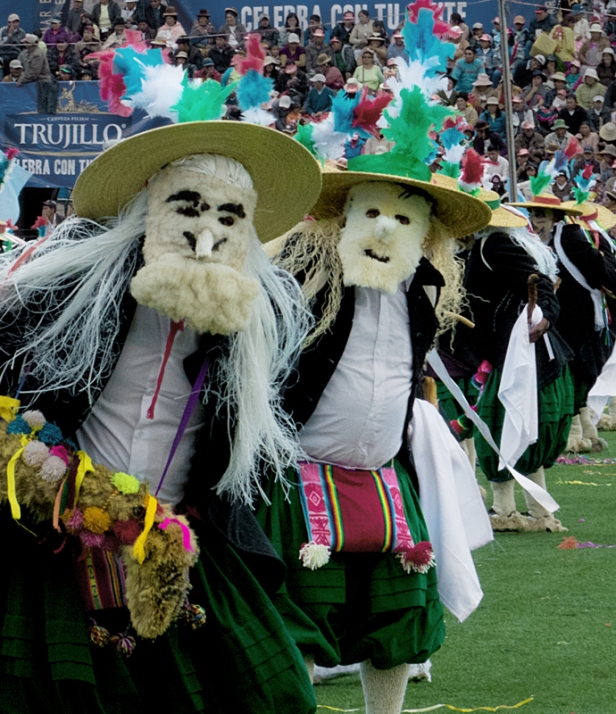


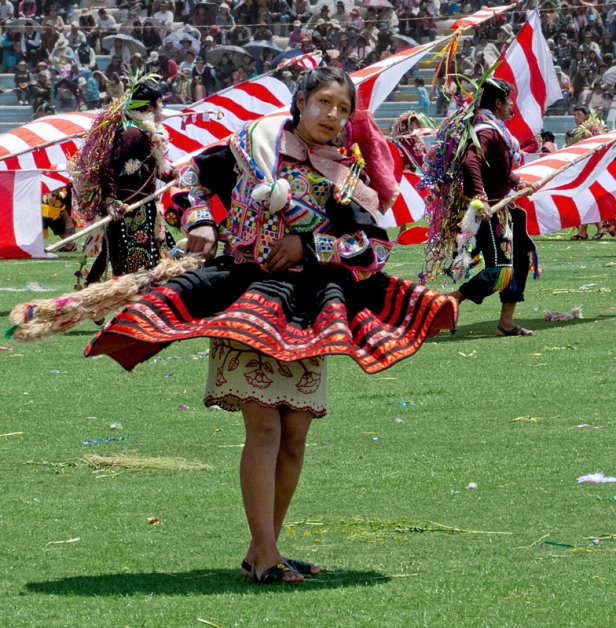

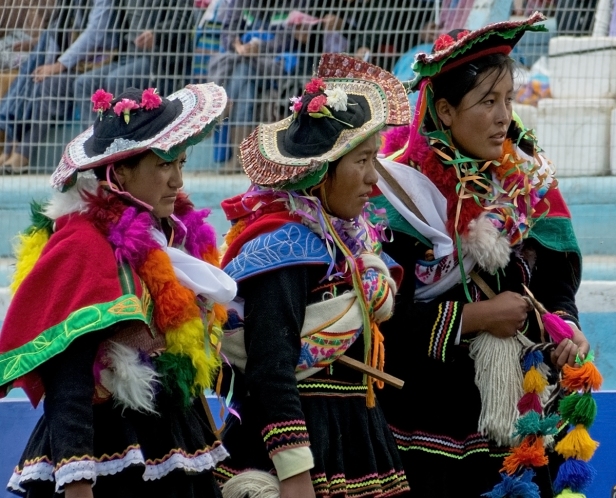
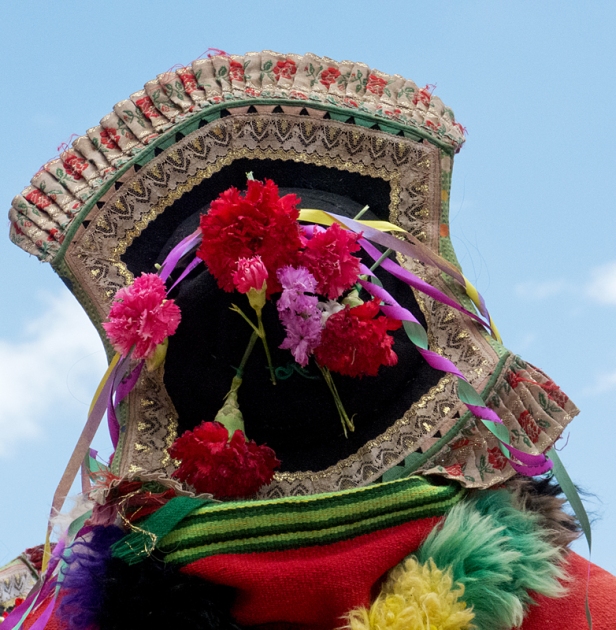



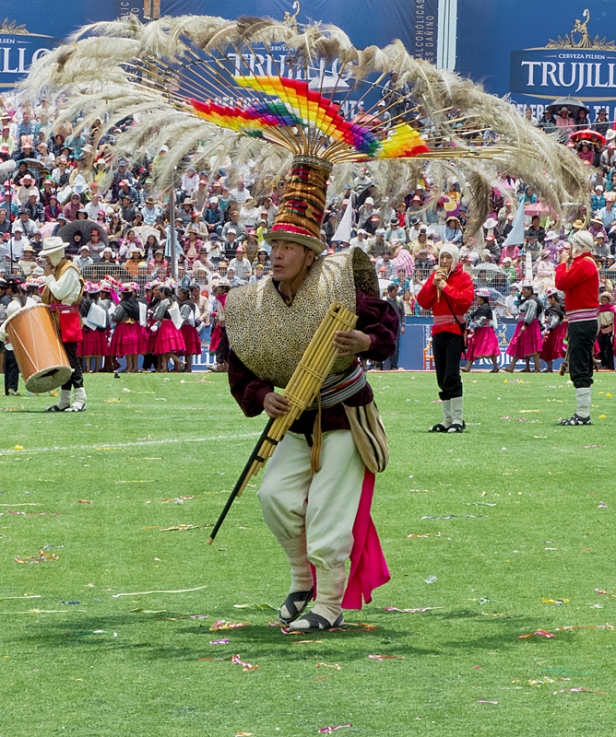

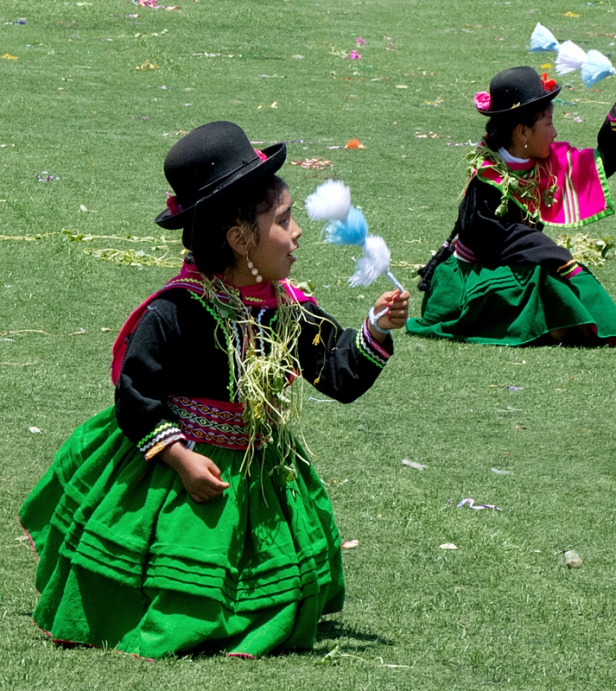



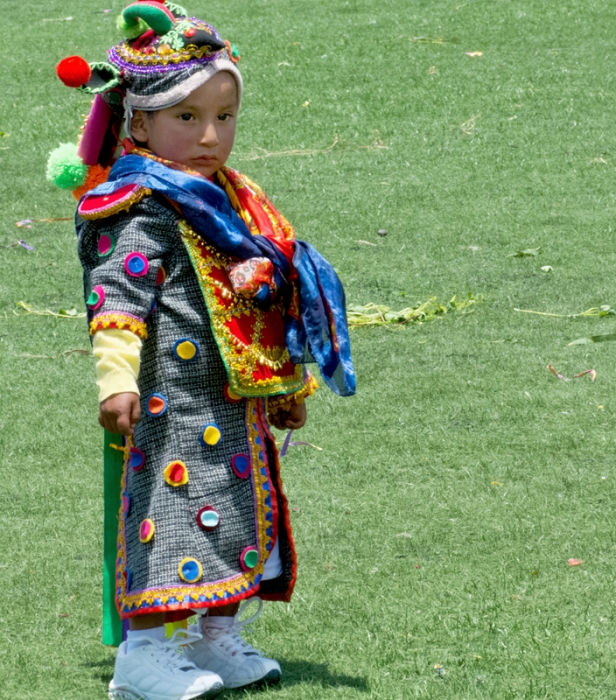

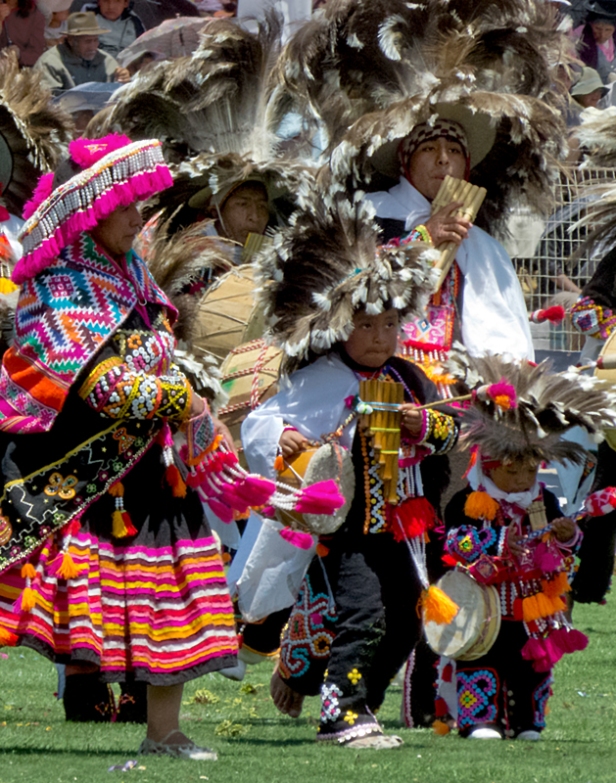
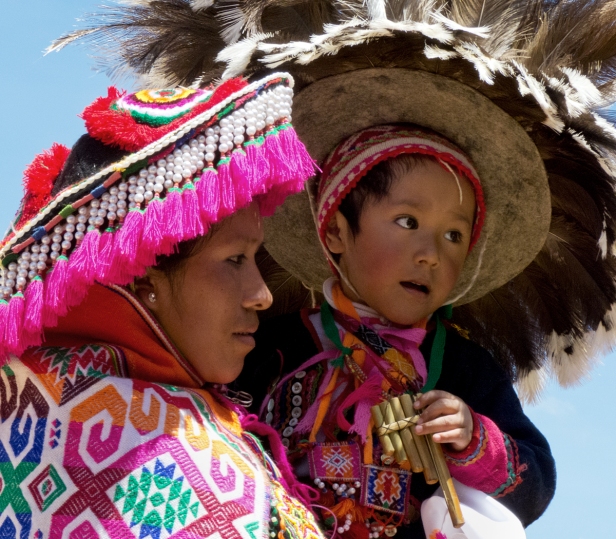
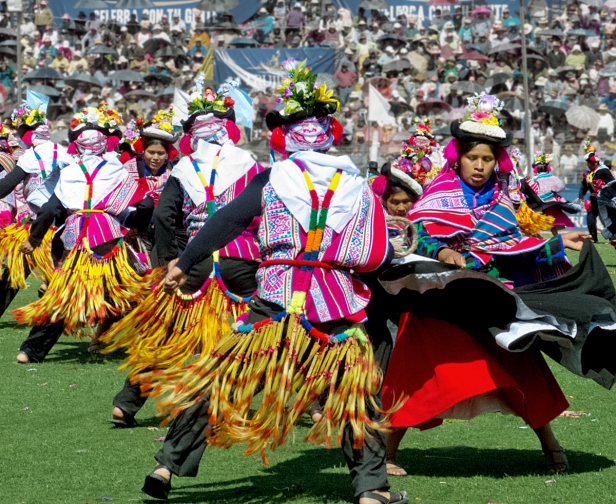
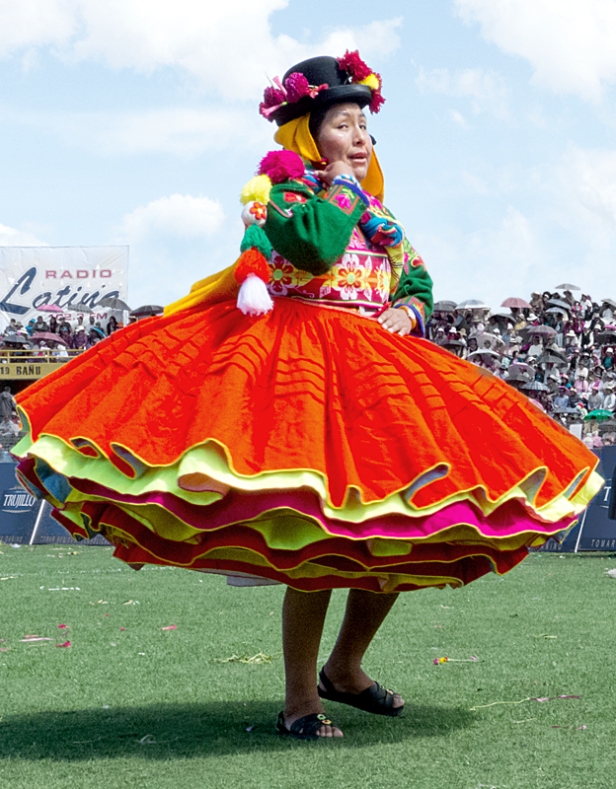
Every now and then the dancing would stop and teams of men would hose down the entire dance ground. And the audience. A welcome relief from the intense heat.
And as the dancers filed off at the end of their dance about one in four took out their cell phones; an incongruous juxtaposition.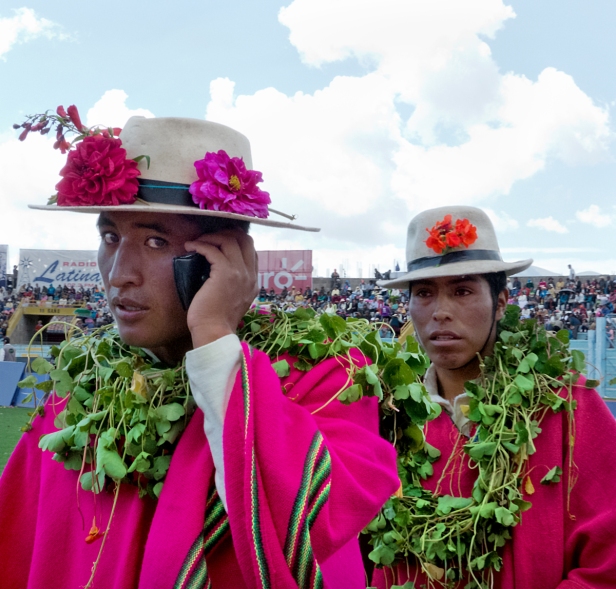
Though they had finished performing at the stadium in the dance competition they were not done yet. From the stadium, following one after the other, each group danced through the streets of Puno to the Church of San Juan, and then down to the Cathedral, around Plaza des Armas and then beyond, taking hours to cover a few kilometres, drinking beer along the way, and sloshing it onto the ground for Pachamama, cheered along by the enthusiastic crowds of thousands lining the streets. Since the last group to perform would probably not have left the stadium until after seven we heard the dancing and music going on well into the night. This was a party that required stamina. And drinking chops. Did I mention beer yet?
Next post: The various processions of the effigy of Candelaria, some more dancing in the streets, and fireworks. Excellent fireworks. And more than a few devils.
All words and images by Alison Louise Armstrong unless otherwise noted
© Alison Louise Armstrong and Adventures in Wonderland – a pilgrimage of the heart, 2010-2015.

Stunning photos, Alison! Is Don feeling better?
LikeLike
Thanks Naomi. This all happened last February. Don’s fine. Thanks for asking.
A
LikeLike
Wow! The pictures are so colorful and show the energy of the people and the festival with the elaborate costumes and dances. I can believe that you could take almost 1300 photos during the event because you wouldn’t want to miss a thing. You must have been grinning from ear to ear all day! Anita
LikeLike
Oh I was definitely grinning from ear to ear. It was an amazing experience – the colour, the creativity, the energy. It was so much fun, especially being in the press area where we had such good access to the dancers – a front row seat so to speak.
Alison
LikeLike
Holy Dinah! Amazing costumes, and your photos, of course. You captured some unique expressions! Love it. Very interesting that it is so huge and rivals Rio’s Carnival too!!!
LikeLike
Thanks Shirley. Yeah! Holy Dinah! It was spectacular. We’d never heard of it, but when we were passing through Puno in late December we heard music in the streets at night so went out to find out what it was. There were huge groups of people dancing in the streets. We were told they were practising for Candelaria and that’s how we first heard of it. We immediately made plane to return to Puno for it.
Alison
LikeLike
Incredible! All the people dancing, the color; the enthusiasm comes through in each photo. Great post, Alison!
LikeLike
Thanks Angeline. Yes, it really was incredible. I hope I’ve conveyed something of the magic of it all – the dedication and enthusiasm and pure joy of them all sharing their dance and music. The audience was wild too, yelling and cheering.
LikeLike
Wonderful photos!
LikeLike
Thank you so much. Glad you enjoyed them.
Alison
LikeLike
Incredible images… it’s really great to see the festivals and customs so different from ours 🙂
LikeLike
Thanks Sreejith. It was so colourful and exciting.
I’ve been to some fabulous festivals in India too – the Pushkar Camel Fair! Amazing! Diwali in Jaipur, and Phool Waalon Ki Sair inDelhi. (there are posts about them if you want to go look)
Alison
LikeLike
Wow… that’s one pretty impressive list, and I am sure you had a great time exploring north India 🙂
I am yet to explore your Indian travel series, let me search 🙂
LikeLike
Wow! My number one place to visit on my bucket list is Peru. Now I have another reason besides Machu Picho. Btw, your photos are fab!
LikeLike
Thanks re the photos. Peru is fabulous in so many ways – Machu Picchu, Cusco and the Sacred Valley, The Uros of Lake Titicaca (make sure you do a 2 day family stay), the Amazon (see previous 2 posts), and the first 2 weeks of February for Casndelaria. Happy travels!
Alison
LikeLike
ethereal place and photos
LikeLike
Thanks Cindy. It was all quite surreal. And fabulous. And nothing much compared to what was to come the following week which was even more extraordinary.
LikeLike
Wow, fabulous post and fantastic photos! What a treat to see this festival.
LikeLike
Thanks so much. It was a huge treat to be there. And this post is only the beginning. The festival lasted 18 days, and the dances in the competition the following Sunday were even more outrageous, is you can believe. It was all quite extraordinary.
LikeLike
I love the colours of their clothing. So vibrant and colourful!
LikeLike
Yes, me too. They’re so beautiful.
LikeLike
Amazing that such a festival exists and until your post alison knew absolutely nothing about it thank you for the visuals and the commentary. felt like I was there with you..eva
LikeLike
Thanks Eva, and you’re welcome. Glad you got a bit of the feeling of it. And this is just the start. The following Sunday there was an even more spectacular dance competition which I’ll also be posting about. We knew nothing about it either until we saw the dancers practicing when we were in Puno a couple of months beforehand.
Alison
LikeLike
As always, Alison, I love the way you capture the local culture, dance and costumes. And I am with you on the cell phones. What a strange world it is when traditional meets up with modern. –Curt
LikeLike
Thanks Curt, glad you enjoyed it. Cell phones seem so incongruous in traditional settings, and yet I must remember that cell phones are one of the greatest inventions for people of developing countries. Before them they had no phones at all, and most I suspect still don’t have land lines, and probably won’t ever have them.
Alison
LikeLike
Right on cell phones Alison. And I might add, immediate connection to the Internet. I have been intrigued for quite some time as to whether the forces pulling the world together or the forces blowing it apart will win. –Curt
LikeLike
The forces pulling the world together for the win! 🙂
LikeLike
Yes!
LikeLike
Those senses again, Alison. The stunning visuals and overpowering colors in the clothing, wow. Running through your description, the smell of wood smoke, beer and (presumably) humans!? The dances followed a pattern — as in circle dances (like Native Americans) or line dances (think Texas bar dancing) or random waltz-like patterns?
LikeLike
Isn’t it all fabulous?! We knew about the dance competitions at the stadium (there was another the following week, even more spectacular, that I’ll cover in a future post) but that whole gathering of the people from the villages I stumbled into by sheer luck.
The dances at the stadium are intricately choreographed, following a pattern (I guess you’d call it geometric), but not circle dances nor line dances though parts of them may be. Imagine 300 dancers on a football field all dancing in a unified pattern – most in matching (or mirroring) choreographed steps, with a few doing individual movements around them. In one group each woman held a high pole with ribbons attached at the top and across to each other’s poles and they danced a pattern with the ribbons. They did this in four groups, one in each section of the dance ground. The guys with furry faces all fell on the ground and waved their legs in the air at one point. One group had hundreds dancing while a smaller section of them performed a ritual kneeling down in a circle. And so on . . . . . . .
Alison
LikeLike
Now I’m getting a visual of quite distinctive “marching bands.” Those elaborate feather headdresses are my personal favorite.
LikeLike
Wow! I felt proudy when i have found your blog. Thnaks to start this wonderful blog and i love all the photos that you have shared on this post.
LikeLike
Thank you so much. Glad you enjoyed it.
Alison
LikeLike
Wow! Your pictures are fabulous, they capture this event so well. You must have been exhausted after the festival–stimulation overload–so many colours, patterns and people to take in everywhere you look. – Ginette
LikeLike
Thanks Ginette. Exhausted? Oh yeah. But this was just the beginning. This was the first 2 days of our 11 days at an 18 day festival. We were just getting started. Those Peruvians sure know how to party. The next 2 posts will also be about Candelaria. It was a truly spectacular event. Not helped by being at nearly 4000 metres altitude, but you get so caught up in the excitement you forget you’re not really getting enough oxygen until you suddenly hit a wall and drag yourself back to your hotel room and collapse for a few hours. I think we maybe attended about half to 2/3 of all that was happening while we were there. There was no way to see all of it. – Alison
LikeLike
Ah, never thought about the altitude, I suppose you do have to take it easy and listen to your body signals. I can’t imagine how the festival could have more that rivals the first day–looking forward to your next posts.
LikeLike
you really captured the beautiful energy emanating so vibrantly during this festive celebration, Alison. what a special treat to witness firsthand. delightful!
LikeLike
Thanks Sun, i’m glad you enjoyed it. It was truly spectacular first hand. The energy was electric – a HUGE 2 week party for the whole region.
LikeLike
How fun to watch and you got to dance too! The dress and colors are wonderful.
LikeLike
Thanks Rebecca. It was really fun, and completely unexpected when he pulled me in to dance with him. The costumes were out of this world. Two more posts about Candelaria to come. A week after this day at the stadium there were another 80 dance groups from the city – their costumes are colourful, bizarre, and unlike anything I’ve ever seen. I’m so glad we decided to go to Candelaria, and we’d only ever even heard of it a month beforehand.
LikeLike
When I read this one and looked at all the pictures, I was struck by the amount of sewing, dying, weaving, and stitching that must take place to put on that kind of pageant each year. Am I wrong, or are most of those ceremonial hats, shirts, and skirts probably still hand made? Either way it is impressive. I have often thought that a downside of the modern world is that you are either an “artist” or you are not- a this or a that. The best at something, or you’re not willing to dive in. Everyone must dive in to bring that festival to life, however. By comparison, it seems sometimes like the modern life produces so few artifacts of its natural unfolding. Everything from a catalog. All of our artifacts are virtual. When I see these pictures, I see a whole world that is stitched together…
Michael
LikeLike
Yes, it’s true, everyone must dive in to bring the festival to life. It belongs to the whole community, everyone participates in some way.The costumes are part hand-made and part machine sewn, and some, that will be the focus of the third post about Candelaria, are machine manufactured from metal. The community connection, and the importance to the economy cannot be overstated. Apart from the dancers and musicians there are another 25,000 people involved – directors, organizers, village elders, priests, choreographers, and, of course, all the artisans who create the costumes and musical instruments. It is a whole world that is stitched together year after year, creating a huge colourful vibrant quilt of community. A Oneness. Something arising from nothing that touches and enriches everyone.
LikeLike
Incredibly stunning ~ Your photos are as amazing as ever, they took me right there with you! I would love to experience this some day; a total experience for all of the senses!
~ Andrea ❤
LikeLike
Thanks so much Andrea. Glad you enjoyed this vicarious experience. It was all very wild and wonderful. Go there! First 2 weeks of February every year. – Alison
LikeLike
Hello friends, I want to congratulate you for your very interesting article. I want to share the following video, hoping it will be of your total satisfaction.
fraternal greetings
LikeLike
Thank you so much for sharing this Marco. I really enjoyed it. We were lucky enough to see some very similar dancers when we were in Cusco. You can see a photo of them in this post:
https://alisonanddon.wordpress.com/2014/03/02/trains-plains-and-cuscos-sexy-woman-2/
Cheers,
Alison
LikeLike
I felt certain when I saw your link on TSMS’s post that I would have seen it. It was right when I was starting my own blog and looking for others (and yours was one of the first, I remember) and I thought Alison + folk festival = of course I’ve seen it! But lo and behold, this was a whole new level of festival! You have such a knack for capturing these vibrant events, and this one may be the best of all. I have probably said that more than a few times, but the colors here, the action, the smoke, the costumes both beautiful and bizarre, and the little spots of anachronistic humor … it all adds up to a visual feast!
LikeLiked by 1 person
Thanks so much Lexie. It was a most amazing festival. We were there for ten days and every day was a visual feast. There are two other blog posts about the same festival in case you’re interested.
We were so lucky to get press credentials for the festival. It made all the difference.
Alison
LikeLike
The motion seems so alive in your photos, I can feel the energy! 💕
LikeLiked by 1 person
Thanks TSMS. I’m glad you caught the feeling. This festival was truly spectacular.
Alison
LikeLiked by 1 person
I love learning about new festivals. This one is certainly colourful. So much rich culture and tradition in Peru… always something more to learn.
LikeLiked by 1 person
We came upon this festival by accident when we were staying in Puno and saw some of the dancers practicing. We immediately changed plans to be there for the festival. it was so worth it. One of the best festivals we’ve been to. We found incredibly rich cultural tradition all throughout South America.
Thanks for reading!
Alison
LikeLiked by 1 person
So good that you did change your plans and were able to share these wonderful photos and descriptions of your experience 🙂
LikeLiked by 1 person
So very colourful! Eye candy!
LikeLiked by 1 person
Aren’t they amazing! It was a most extraordinary festival with about 50,000 participants. Days of eye candy.
Alison
LikeLike